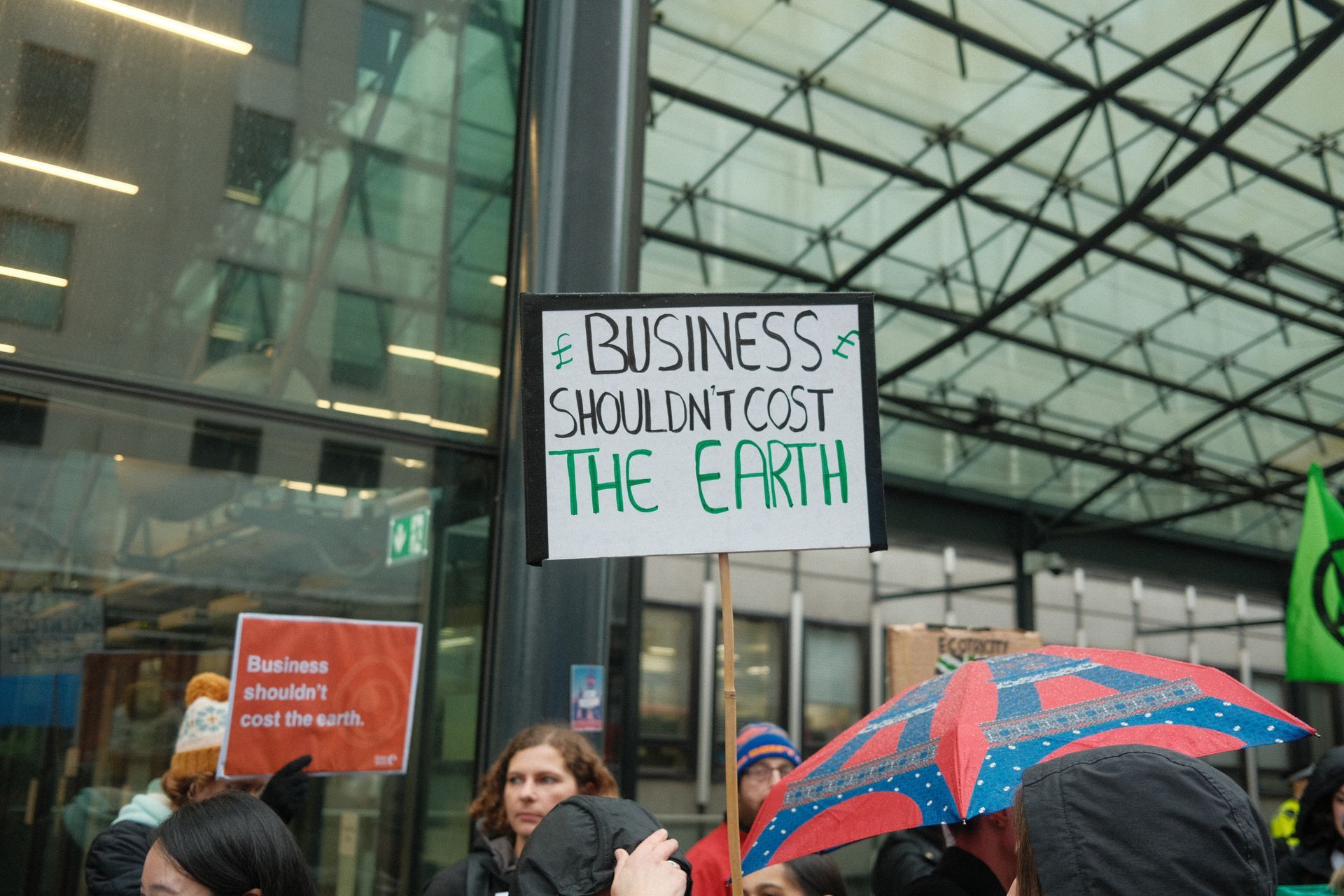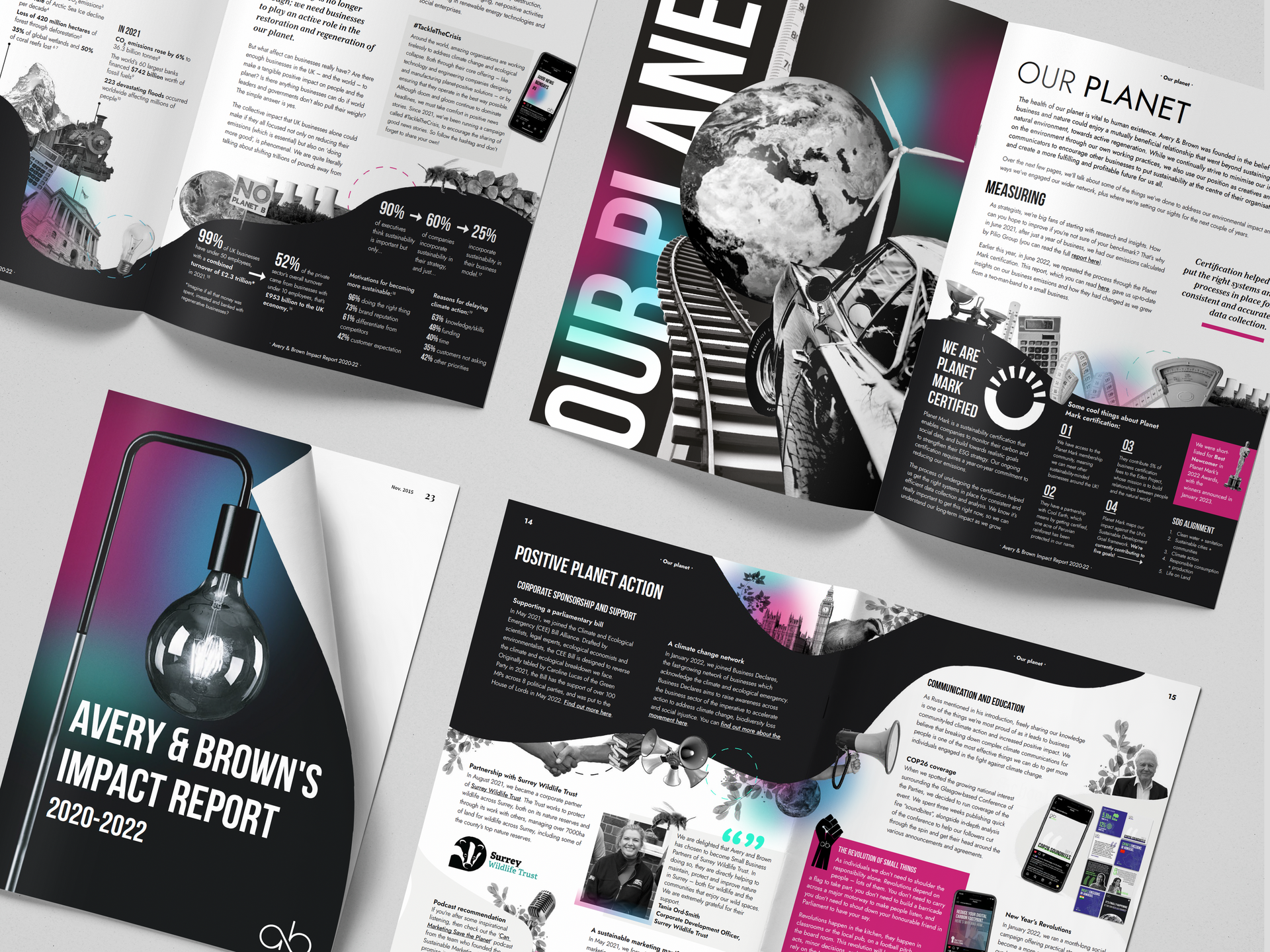Avery & Brown’s Ultimate Guide to Impact Reporting
It's time for businesses to be better
Let’s be honest, businesses don’t tend to have the best reputation when it comes to environmental impact, especially the built environment sector with its estimated 40% contribution to global greenhouse gas emissions.
We’re in the middle of a climate crisis right now, and as things get considerably worse for people and the planet, the voice of society gets considerably louder in demanding that governments and businesses put a foot down and start doing things the right way.
The good news is, more and more businesses actually are starting to realise the big role they have in creating a sustainable future, and have begun shifting attention towards measuring, declaring, and improving the impact they have.
How does reporting your impact help?
For businesses that do care about positive change, impact reporting is an amazing way of showing how you’re going the extra mile and doing more in your day-to-day than the average traditional business.

Picture this - You’re a frontrunner in your industry who’s wholly committed to doing things better. Doesn’t it make sense that you’d want to let everyone else know about it? Not just to make waves about your business, but to inspire others too?
For any aspiring or existing B Corps out there, impact reporting is an essential. In B Lab’s own words, B Corps are ‘working together to reinvent the role of business in society’, so it makes sense that B Corps are required to report their impact in their 3 year period of certification.
So, what actually is an impact report? How do they compare against sustainability or ESG reports? How can you get started with making one?
Communicating impact
For a business new to the reporting scene, impact reports can sound a lot like a sustainability or ESG report, two other reporting styles that are cut from the same cloth.
Let’s take a closer look at the different types of reports to make heads or tails of them:
1. The sustainability report:
- Focuses on the environmental, social, and economic impact of a business.
- Usually communicates information on the business’s strategies, activities, and performance in terms of sustainability.
- Are often guided by frameworks like the Global Reporting Initiative (GRI) or the United Nations Sustainable Development Goals (UNSDGs).
- Shows data on energy usage, waste and recycling, carbon footprint, employee engagement, diversity and inclusion, community engagement, and supply chain management.
- Demonstrates a business’s commitment to sustainable practices and its impact on the environment and society.
2. The ESG report:
- Stands for Environmental, Social, and Governance and a report will provide information on a business’s performance in these three areas.
- The environmental aspect will review how the business’s operations affect the natural environment (e.g. carbon emissions, waste management, and resource conservation).
- The social aspect covers how the business manages relationships with employees, suppliers, customers, and the communities where it operates (e.g. working conditions, human rights, and community development).
- The governance aspect pertains to a business’s leadership, executive pay, audits, internal controls, and shareholder rights. Many investors use ESG reports to assess the risks and opportunities related to sustainable investment.
- Has several ESG standards, such as those from the Sustainability Accounting Standards Board (SASB), that guide these reports.
3. The impact report:
- Focuses on the measurable outcomes of a business’s specific initiatives or investments, especially those taking aim at positive social or environmental change.
- Often use key performance indicators (KPIs) to quantify and demonstrate changes that have been made because of the business’s actions.
- Are usually used instead of the traditional sustainability report by organisations that have a specific mission or purpose beyond profitability, such as social enterprises, impact investors, and non-profit organisations.
- Typically outline a problem the business is trying to solve, its approach, and the outcomes or impacts of its actions.

To recap:
- A sustainability report is a document that usually takes a broad view of a business’s activities and their impact on society and the environment.
- An ESG report is a document that provides a detailed account of a business’s performance in environmental, social, and governance areas, often with the intent of informing investment decisions.
- An impact report is a document that focuses on the specific outcomes and impacts of a business’s initiatives or investments, often tied to a specific mission or purpose beyond profitability.
Get all that? Even though there’s some overlap with the topics these reports cover, they have a subtle difference in their focus.
Is an impact report better than a sustainability or ESG report?
Not necessarily. Despite their differences, all 3 reporting styles have something in common; they’re used by businesses that have a focus on purpose beyond profit to communicate the positive difference they’re making.
The nature of business has been changing in recent years, and businesses are no longer expected to solely cater towards shareholders through the focus of maximising profits. Instead, there’s now a much bigger focus on balancing the interests of the stakeholder too.
That means the traditional shareholder-centric annual report used to communicate business operations and financial performance just doesn’t cut it anymore.
Why is it important to report your impact the ‘right’ way?
This recent shift of focus towards stakeholder needs has given rise to a new label you may or may not have heard before; ‘stakeholder capitalism’.

The idea here is that capitalism has evolved into a new form, creating a world where stakeholder interests (like those held by employees, clients, and suppliers) are more important or are just as important as the interests of shareholders.
What we get from this is a switch up from the usual corporate focus on ‘short-term results at the expense of long-term interests’, to a more stakeholder-friendly focus that prioritises long-term value.
By taking stakeholder interests into account, businesses can start leveraging the things that stakeholders prioritise, such as sustainable/ethical business practices and employee happiness as ‘values’ that can be shared and reported on.
As to what businesses actually get out of communicating focus on long-term value, the payoff can be anything like:
- Appearing more appealing to new clients
- Attracting a wider range of talented employment prospects
- Enhancing business value
You can probably start to see how, if used by a business that doesn’t actually have a genuine care for stakeholder interests and is instead using it to appear a cut above the competition, this could be disingenuous and dangerous.

Just take a look at HSBC's climate change campaign from last year. A nice little poster for the run-up to COP26, stating that the bank had been investing however many billions in helping clients transition to Net Zero, while ignoring the very large and ugly fact that the bank had also been busy funding greenhouse-gas emitting companies at the same time. The emissions related to the customers it financed were equivalent to around 65.3 million tonnes of CO2 per year for oil and gas alone.
For a business that actually is looking to make meaningful change and communicate it in the right way, this is the exact type of thing you want to avoid when publishing a report.
If full transparency isn’t shown to stakeholders and full accountability isn’t taken by the business, impact reports can run the risk of looking like just another piece of marketing collateral looking to cash in on some long-term value.
Even if the heart of a business is in the right place, when an impact report isn’t done right, it can sometimes be hard for a stakeholder to navigate what is genuine care for sustainable practices, or just plain old greenwash.
Then how can businesses approach this properly?
The nature of the impact report
In today’s climate, a lot of businesses aren’t regenerative, sustainable, or even trustworthy (just like our friends at HSBC); and impact reporting is that one golden opportunity to shout to the world that businesses can in fact make the world a better place. It’ll not only show what a purpose-driven business is achieving in the current year, it’ll also show what can be achieved and how it can be done.

Impact reporting isn’t just showing data that tells the story of a business, it’s showing data that sets out the sequel. It’s an invitation to show how a business operates and tells the reader ‘this is who we are, what we do, why we do it, and how we’re going to be even better next year’. It’s a great way to display the outcomes of your business practices and the effect they have, whether they’re ups and downs or wins and losses.
Keeping it real
For businesses truly trying to achieve great things, success and progress won’t always be linear, especially when taking big strides. It might be tempting for some to sweep the rough patches under the rug and focus on success, but stakeholders can and will sniff that out, especially if you bend the truth, leave out relevant information, or just straight up lie. It’s ok if you didn’t meet your targets this year. Shit happens sometimes.
That doesn’t mean businesses shouldn’t be communicating accomplishments (because they definitely should), but it’s important to remember that an impact report is about genuine transparency, and displaying how a business will be progressing past hardships and learning from the experience is all part of the impact reporting journey.
What do impact reports look like in the wild?
If you’ve not seen an impact report before and are interested in seeing some good examples, check out The Impact Reporting Archive. This website specialises in storing and showcasing impact reports from businesses all over the world and is constantly receiving new uploads.
Let’s get started
Right, so you’ve listened to us ramble on and now you’re thinking ‘cool, how do I actually sit down and write an effective impact report?’. When we were publishing our own earlier this year, we realised that the world of impact reporting could be a scary place for a business new to the concept.

Pulling an impact report together and executing it effectively can be a lot of hard work, but our combined extensive expertise in marketing, communications, design, sustainability AND sustainability and ESG reporting means that we've been able to come up with a highly effective formula for impact reporting.
In theory, the content of an impact report could be communicated in tons of different ways; through a powerpoint, a LinkedIn post, or a really boring spreadsheet full of numbers, but that just doesn’t have any ‘oomph’ to it, does it?
Impact reporting our way
In our own special Avery & Brown brew, we combine our creative, strategy, and sustainability expertise to create a piece of work tailored to your business and your needs.
Whether you’re looking to create your first impact report this year or need some comprehensive data given a new lease of life, why not get in touch? We’re only one click away.
P.S. We might specialise in impact reports, but we have the same experience when it comes to creating sustainability and ESG reports too. Those are just as important!
A few tips from us
We didn’t want to sign off from this blog without leaving you something to take home. Impact reporting isn’t supposed to be a members-only club, and getting resources out there that can educate other businesses on publishing their first impact report is something that we definitely wanted to lend a hand on. The more the merrier, right?
That’s why on top of launching our own impact reporting services, Russ released a brand new email course,
'9 Top Tips for Effective Impact Reporting', for free last month.
We hit the maximum number of sign-ups, which is obviously great to see, but it also meant that anyone who didn’t make the signup list would be missing out on all the information we have to share.
The good news is that as of today, the entire course is now open to the public (and still free of course) in
Russ’ new blog.
Share the love


















